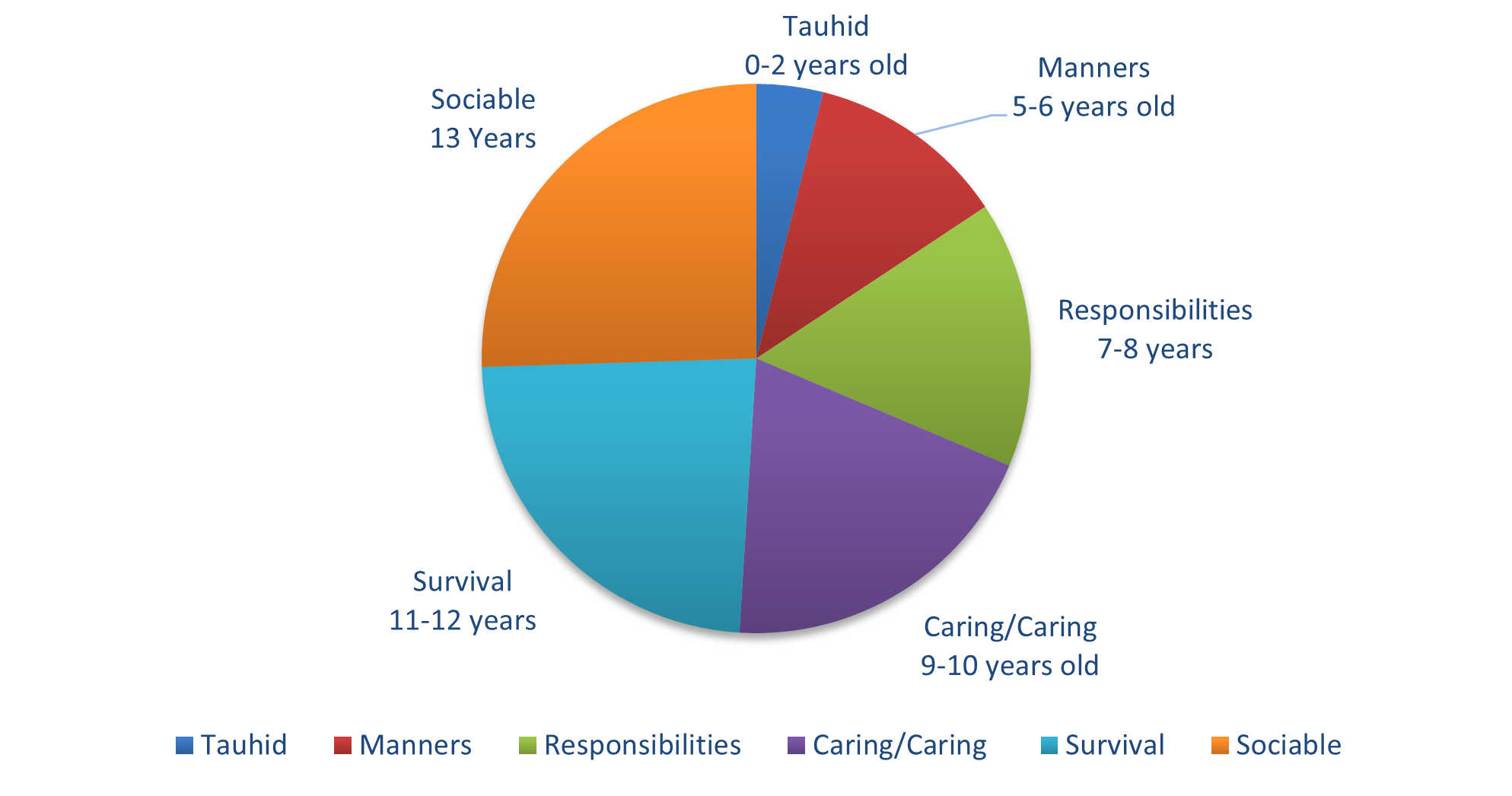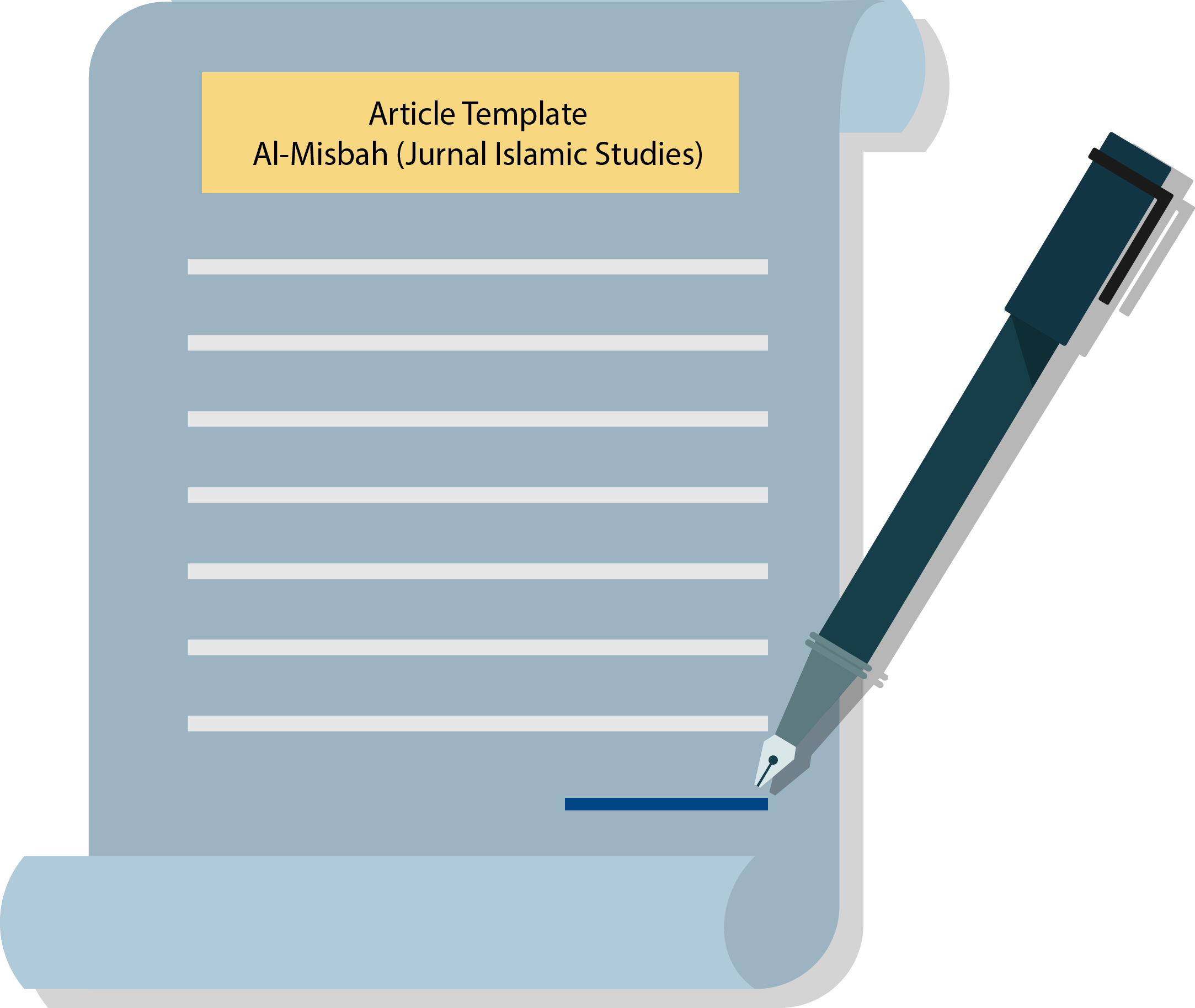Concept and Implementation of Islamic Character Education in Educational Institutions
DOI:
https://doi.org/10.26555/almisbah.v10i2.6734Keywords:
Character Education, Educational Institutions, Concept and Implementation, Islamic EducationAbstract
Education institutions must implement Islamic character education on a massive scale immediately. This study aims to describe the concept and implementation of character education in educational institutions to address student association issues without delay. This investigation is library-based (library research). The obtained data were then analyzed with a hermeneutic approach through content analysis. This study concludes that the concept of character education has been taught in Islam for quite some time. The verses of the Qur'an and hadith explain this. Similar to Surah Luqman verses 17 and 18, as well as the hadith narrated by Imam Bukhari and Muslims from the path of Abdullah bin Amr bin Ash's companions. Implementing Islamic character education in educational institutions can be categorized initially by age range, from early childhood to adolescence. To evaluate the success of Islamic character education in specific educational institutions, class-based, school-based, and community-based Islamic character education must be implemented. The implication for educational institutions is a greater emphasis on Islamic character education beginning at a young age so that students develop Islamic character. This study contributes to advancing and implementing Islamic character education in educational institutions.
References
A, P. (2021). Hanuman’s Characteristics among the characters of Kambar. International Research Journal of Tamil, 4(1). https://doi.org/10.34256/irjt2213
Acetylena, S. (2018). Bahasa dan Pendidikan Karakter dalam Pandangan KI Hadjar Dewantara (Perspektif Teori Kritis Habermas). Al-Wijdan : Journal of Islamic Education Studies, III(1).
Akbar, S. (2010). Model Pembelajaran Nilai dan Karakter Berbasis Nilai-Nilai Kehidupan di Sekolah Dasar. Jurnal Imu Pendidikan.
Amirullah Syabrani. (2012). Pendidikan Karakter. Prima Pustaka.
Arinda Firdianti. (2018). Implementasi Manajemen Berbasis Sekolah Dalam Meningkatkan Prsetasi Belajar Siswa. CV. Gre. Publishing.
Asa, A. I. (2019). Pendidikan karakter menurut ki hadjar dewantara dan driyarkara. Jurnal Pendidikan Karakter, 9(2). https://doi.org/10.21831/jpk.v9i2.25361
Bai, Y., Zhou, W., Guan, Y., Li, X., Huang, B., Lei, F., Yang, H., & Huo, W. (2020). Evolution of policy concerning the readjustment of inefficient urban land use in China based on a content analysis method. Sustainability (Switzerland), 12(3). https://doi.org/10.3390/su12030797
Daharum, M. (2020). Konsep Insan Kamil Perspektif Abdul Karim al-Jili dan Relevansinya di Era Modern. Skripsi Raden Intan Lampung.
Effendi, Y. R., Bafadal, I., Degeng, I. N. S., & Arifin, I. (2020). The principal’s transformational leadership approach based on local wisdom in strengthening the character of students. Malaysian Online Journal of Educational Management, 8(4). https://doi.org/10.22452/mojem.vol8no4.2
Effendi, Y. R., Bafadal, I., Sudana, I. N. D., & Arifin, I. (2020). The principal transformational leadership strategy in developing national policies for strengthening character education in eastern Indonesia. Italian Journal of Sociology of Education, 12(2). https://doi.org/10.14658/pupj-ijse-2020-2-3
Egbinola, C. N., & Amanambu, A. C. (2015). Water supply, sanitation and hygiene education in secondary schools in Ibadan, Nigeria. Bulletin of Geography. Socio-Economic Series, 29(29). https://doi.org/10.1515/bog-2015-0023
Elkind, David H., and Sweet, F. (2004). How to do Character Education. Live Wire Media.
Elkind, D. H., & Sweet, F. (1997). The Socratic approach to character education. Educational Leadership, 54(8).
Elkind, D. H., & Sweet, F. (2012). How to Teach Character Education. In Https://Www.Goodcharacter.Com/How-To-Articles/How-To-Teach-Character-Education/.
Fadli, M. R. (2021). Implementation of Sociocultural Based Character Education in Senior High School. Jurnal Pendidikan Karakter, 12(2). https://doi.org/10.21831/jpka.v12i2.41957
Ferary, D. (2021). On Ki Hadjar Dewantara’s Philosophy of Education. Nordic Journal of Comparative and International Education (NJCIE), 5(2). https://doi.org/10.7577/njcie.4156
Fishelov, D. (1990). Types of Character, Characteristics of Types. Style, 24(3).
Fitri, A. (2018). Pendidikan karakter prespektif al-quran hadits. TA’LIM : Jurnal Studi Pendidikan Islam, Vol.1 No.2.
Hasan, Y., & Firdaos, R. (2017). Penguatan Pendidikan Karakter Berbasis Masyarakat pada Sekolah Menengah Pertama Negeri (SMPN) di Kabupaten Tulang Bawang Provinsi Lampung. Al-Tadzkiyyah: Jurnal Pendidikan Islam, 8(2). https://doi.org/10.24042/atjpi.v8i2.2131
Holmboe, E. s, & Lobst, W. F. (2020). Assessment Guidebook. Accreditation Couincil for Graduate Medical Education.
IBRAHIM, S. (2019). Introducing heritage vocabulary into contemporary architecture to preserve the future of heritage. International Journal of Architectural Engineering and Urban Research, 2(1). https://doi.org/10.21608/ijaeur.2019.179829
Imron, I. (2019). Analisa Pengaruh Kualitas Produk Terhadap Kepuasan Konsumen Menggunakan Metode Kuantitatif Pada CV. Meubele Berkah Tangerang. Indonesian Journal on Software Engineering (IJSE). https://doi.org/10.31294/ijse.v5i1.5861
Indah. (2017). Penggunaan Media Video Call dalam Teknologi Komunikasi. Jurnal Ilmiah Dinamika Sosial.
Iskandar. (2020). Implementation of Culture-Based Character Education Management through the Application of Blended Learning as a source of Social Sciences Learning (IPS). International Journal of Psychosocial Rehabilitation, 24(03). https://doi.org/10.37200/ijpr/v24i3/pr200956
Jalaluddin. (2002). Mempersiapkan Anak Saleh. Srigunting.
Kaya, E., Erden, D., Kayar, A. H., & Kiralp, M. Z. (2010). Alexithymia, temperament and character characteristics in women with fibromyalgia syndrome. Turkiye Fiziksel Tip ve Rehabilitasyon Dergisi, 56(3). https://doi.org/10.4274/tftr.56.105
Kwon, Y., Kim, S. J., Kim, J., Kim, S. Y., Song, E. M., Lee, E. J., Choi, Y., Kim, Y., Lim, B. O., Kim, D. S., Choi, D., Kim, H. S., Park, J. E., Yun, J. E., Park, J. A., Jung, J. R., Kim, J. K., Kang, S. H., Hong, S. Y., … Kwon, G. Y. (2014). Results of Tuberculosis Contact Investigation in Congregate Settings in Korea, 2013. Osong Public Health and Research Perspectives, 5(S). https://doi.org/10.1016/j.phrp.2014.10.010
Latief, S., Sari, Y. A., Yusuf, M., Armila, A., & Hidayat, R. E. (2021). The Development of Islamic Education and Strengthening of National Education System of Indonesia. International Journal on Advanced Science, Education, and Religion, 4(2). https://doi.org/10.33648/ijoaser.v4i2.105
Majid, A & Andayani, D. (2012). Pendidikan Karakter Perspektif Islam. PT.Remaja Rosdakarya.
Manullang, S. O., & Satria, E. (2020). The Review of the International Voices on the Responses of the Worldwide School Closures Policy Searching during Covid-19 Pandemic. Jurnal Iqra’ : Kajian Ilmu Pendidikan, 5(2). https://doi.org/10.25217/ji.v5i2.1036
Moto, M. M. (2019). Pengaruh Penggunaan Media Pembelajaran dalam Dunia Pendidikan. Indonesian Journal of Primary Education. https://doi.org/10.17509/ijpe.v3i1.16060
Mukromin. (2017). Implementasi Pendidikan Karakter Di Pesantren. Tadrib: Jurnal Pendidikan Agama Islam, XIII.
Persram, R. J., Howe, N., & Bukowski, W. M. (2022). Constructing and Validating a Measure of Adolescents’ Perceptions of Sibling Trust. Canadian Journal of Behavioural Science, 54(1). https://doi.org/10.1037/cbs0000281
Poerwadarminta. (2007). Kamus Umum Bahasa Indonesia. Balai Pustaka.
Ravshanbekovna, S. S. (2021). Use of innovative technologies in teaching organic chemistry. Psychology and Education Journal, 58(2). https://doi.org/10.17762/pae.v58i2.2895
Ridwan, R., & Wulansari, W. (2019). Menumbuhkan Karakter Anak Usia Dini Melalui Cerita Boneka Tangan dalam Model Tadzkirah. Proceedings of The ICECRS, 2(1). https://doi.org/10.21070/picecrs.v2i1.2408
Sabartiningsih, M. dkk. (2018). Implementasi Pemberian Reward Dan Punishment Dalam. Jurnal Pendidikan Anak, 4.
Sabartiningsih, M., Muzakki, J. A., & Durtam, D. (2018). Implementasi pemberian reward dan punishment dalam membentuk karakter disiplin anak usia dini. AWLADY : Jurnal Pendidikan Anak, 4(1). https://doi.org/10.24235/awlady.v4i1.2468
Saihu, Aziz, A., Mubin, F., & Sarnoto, A. Z. (2020). Design of islamic education based on local wisdom (An analysis of social learning theories in forming character through ngejot tradition in bali). International Journal of Advanced Science and Technology, 29(6).
Schmiedek, F., & Neubauer, A. B. (2020). Experiments in the Wild: Introducing the Within-Person Encouragement Design. Multivariate Behavioral Research, 55(2). https://doi.org/10.1080/00273171.2019.1627660
Sidik, H., & Sulistyana, I. P. (2021). Hermeneutika Sebuah Metode Interpretasi Dalam Kajian Filsafat Sejarah. AGASTYA: JURNAL SEJARAH DAN PEMBELAJARANNYA. https://doi.org/10.25273/ajsp.v11i1.6224
Strecker, C., Huber, A., Höge, T., Hausler, M., & Höfer, S. (2020). Identifying thriving Workplaces in Hospitals: Work Characteristics and the Applicability of Character Strengths at Work. Applied Research in Quality of Life, 15(2). https://doi.org/10.1007/s11482-018-9693-1
Subramanian, A. (2017). Teacher education from e-learner to e-teacher. International Journal of Research -GRANTHAALAYAH, 5(4(SE)). https://doi.org/10.29121/granthaalayah.v5.i4(se).2017.1946
Sujana, A., & Komariah, A. (2020). Entrepreneurship Competency Training Model of Private High School Principal Through Knowledge-Based Economy Approach. https://doi.org/10.2991/assehr.k.200130.151
Sumardiyani, L., Murniati, N. A. N., & Reffiane, F. (2018). Rancang bangun model monev pendidikan karakter. JP3 (Jurnal Pendidikan Dan Profesi Pendidik), 1(1). https://doi.org/10.26877/jp3.v1i1.2194
Syafri, U. A. (2012). Pendidikan Karakter Berbasis Al Qur’an. Rajawali Pers.
Ulil Amri Syarif. (2012). Pendidikan Karakter Berbasis Al-Qur’an. Raja Grafindo Press.
Wiradimadja, A., Ratnawati, N., Kurniawan, B., Yaniafari, R. P., & Alivi, J. S. (2021). Screen Recorder for Guiding Distance Learning: Case Study of Teacher Professional Education Program. International Journal of Emerging Technologies in Learning, 16(7). https://doi.org/10.3991/ijet.v16i07.21173
Wright, D. B., Hanoteau, F., Parkinson, C., & Tatham, A. (2010). Perceptions about memory reliability and honesty for children of 3 to 18 years old. Legal and Criminological Psychology, 15(2). https://doi.org/10.1348/135532508X400347
Xie, X., Huo, J., & Zou, H. (2019). Green process innovation, green product innovation, and corporate financial performance: A content analysis method. Journal of Business Research, 101. https://doi.org/10.1016/j.jbusres.2019.01.010
Yunahar Ilyas. (2005). Kuliah Akhlaq. Lembaga Pengkajian dan Pengamalan Islam (LPPI).
Yunita, Y., & Mujib, A. (2021). Pendidikan karakter dalam perspektif Islam. Jurnal TAUJIH, 14(01). https://doi.org/10.53649/jutau.v14i01.309

Downloads
Published
How to Cite
Issue
Section
License
Copyright (c) 2022 Muh. Alif Kurniawan , Fadhlurrahman Fadhlurrahman, Zalik Nuryana

This work is licensed under a Creative Commons Attribution-ShareAlike 4.0 International License.
Authors who publish with Al-Misbah agree to the following terms:
- Authors retain copyright and grant the journal right of first publication with the work simultaneously licensed under a Creative Commons Attribution License (CC BY-SA 4.0) that allows others to share the work with an acknowledgment of the work's authorship and initial publication in this journal.
- Authors are able to enter into separate, additional contractual arrangements for the non-exclusive distribution of the journal's published version of the work (e.g., post it to an institutional repository or publish it in a book), with an acknowledgment of its initial publication in this journal.
- Authors are permitted and encouraged to post their work online (e.g., in institutional repositories or on their website) prior to and during the submission process, as it can lead to productive exchanges, as well as earlier and greater citation of published work.

This work is licensed under a Creative Commons Attribution-ShareAlike 4.0 International License.



